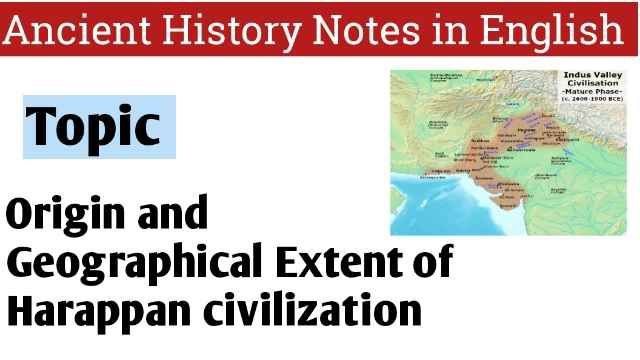Origin and Geographical Extent of Harappan civilization: In this article we will discuss about Origin and geographical Extent of Harappan civilization.
Introduction of Harappan Civilization (Bronze Age) – c.2600 – 1900 BCE
Earlier historians had called this civilisation “The Indus Valley Civilisation”, but later on, major settlements have been excavated in the Ghaggar – Hakra belt that spread beyond the Indus region. The Harappan civilisation was the first urban civilisation in South Asia, contemporary to Mesopotamia (present-day Iraq) and Egyptian civilisation. Among the three civilizations, the Harappan civilisation occupied about 8,00,000 sq. km, a larger area than the other two civilizations. It rose in the North-Western part of the Indian sub-continent. It is called Harappan because this civilization was first discovered in 1921 at the modern site of Harappa situated in the province of West Punjab in Pakistan. It forms a part of the proto-history of India and belongs to the bronze age. Although it is regarded as older than the chalcolithic cultures, it was far more developed than these cultures.
Origin of Harappan Civilization
The archaeological remains show that before the emergence of Harappan civiliza- tion the people lived in small villages. As the time passed, there was the emergence of small towns which ultimately led to full-fledged towns during the Harappan period. The whole period of Harappan civilization is in fact divided into three phases:
(i) Early Harappan phase (3500 BC-2600 BC)
it was marked by some town-planning in the form of mud structures, elementary trade, arts and crafts, etc. It was marked by the people living in large villages in the plains. The transition from rural to urban life took place during this period. The sites of Amri and Kot.
(ii) Mature Harappan phase (2600 BC-1900 BC)
it was the period in which we notice well- developed towns with burnt brick structures, inland and foreign trade, crafts of vari- ous types, etc.It was characterized by the emergence of great cities and urban centres. Such urban centres are represented by Harappa, Mohenjodaro, Dholavira, Rakhigarhi etc. The excavations at Kalibangan also, with its elaborate town planning and urban features prove this phase of evolution.
(iii) Late Harappan phase (1900 BC-1400 BC)
It was marked by the beginning of the decline of the Indus civilization. The excavations at Lothal reveal this stage of evolution. However, the Indus Valley Civilisation did not disappear suddenly and many elements of the civilization can be found late until about 1000-900 BCE.
- Write a detailed note on Kayatha Culture and its salient features
- Features of the Harappan civilisation
- Write an essay on Jorwe Culture
- Definition of Archaeology and its relation with social science
- Definition of Archaeology and its relation with natural science
- Salient features of Vedic Culture
- Main features of Egyptian Civilization
Extent of Harappan Civilization
The Indus Valley Civilization covered an area far greater than the area covered jointly by the contemporary civilizations of Egypt and Mesopotamia. It extended from the valley of the Saraswati-Sutlej, along the Indus, upto Saurashtra According to Dr. V.S. Agarwala, almost one third of India, covering about half a million square miles, stretching from Rupar in Ambala district to Bhagatro on the Kim river (midway between the Narmada and the Tapti), the southern-most settlement known so far, was the arena of origin and growth of the Indus Valley Civilization.
After partition in 1947, the note worthy sites discovered in India are Manda in Jammu district-representing the northern limit, Alamgirpur in Meerut district representing the easternmost; Diamabad on the banks of Pravara a tributary of river Godavari and Lothal and Rangpur in Ahmedabad and Surendranagar districts respectively in Gujarat, representing the south- ern most limit. As far as western limit is concerned, all sites (including Harappa and Mohejadaro) are now in Pakistan. Of course Sutkagendor on the coastal flats of Baluchistan marks the western limit.

